Comprehensive Analysis: Apple Brand Management Report
VerifiedAdded on 2023/01/13
|18
|4996
|93
Report
AI Summary
This report provides a comprehensive analysis of Apple's brand management strategies, covering key aspects such as the importance of branding, components of a successful brand strategy, portfolio management, brand hierarchy, and techniques for measuring brand value. It explores branding as a marketing tool, examining brand loyalty, awareness, perceived quality, association, and proprietary assets. The report delves into Apple's approach to leveraging its brand through portfolio management, strategic analysis, and different brand strategies like branded house, house of brand, and hybrid models. Furthermore, it discusses the significance of brand hierarchy in connecting products with customers, highlighting Apple's approach to building a strong brand presence in the market. The report also includes a discussion on the strategies for portfolio management and brand hierarchy, along with how brands are managed at both domestic and global levels, and techniques for measuring brand value.

BRAND MANAGEMENT
Paraphrase This Document
Need a fresh take? Get an instant paraphrase of this document with our AI Paraphraser
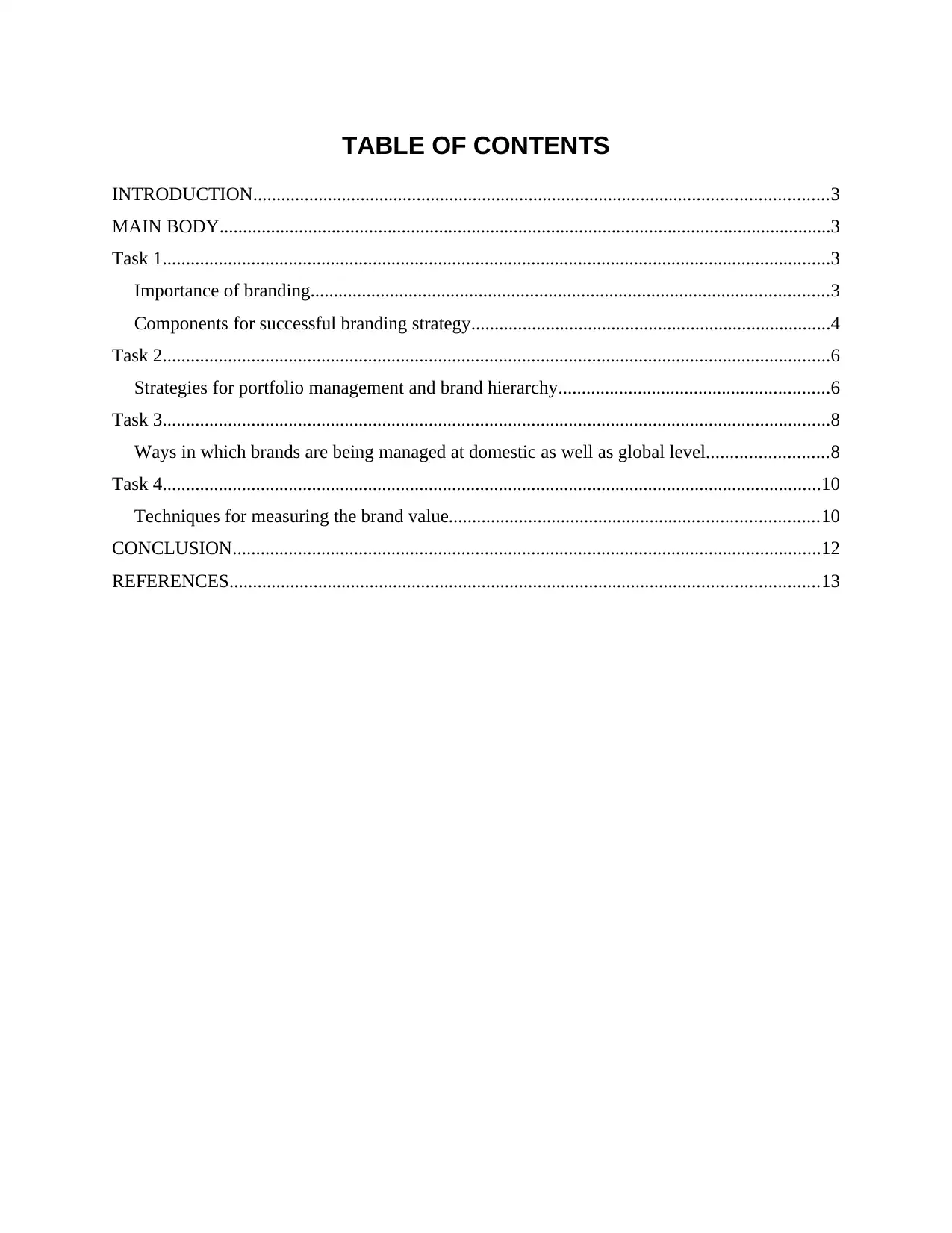
TABLE OF CONTENTS
INTRODUCTION...........................................................................................................................3
MAIN BODY...................................................................................................................................3
Task 1...............................................................................................................................................3
Importance of branding...............................................................................................................3
Components for successful branding strategy.............................................................................4
Task 2...............................................................................................................................................6
Strategies for portfolio management and brand hierarchy..........................................................6
Task 3...............................................................................................................................................8
Ways in which brands are being managed at domestic as well as global level..........................8
Task 4.............................................................................................................................................10
Techniques for measuring the brand value...............................................................................10
CONCLUSION..............................................................................................................................12
REFERENCES..............................................................................................................................13
INTRODUCTION...........................................................................................................................3
MAIN BODY...................................................................................................................................3
Task 1...............................................................................................................................................3
Importance of branding...............................................................................................................3
Components for successful branding strategy.............................................................................4
Task 2...............................................................................................................................................6
Strategies for portfolio management and brand hierarchy..........................................................6
Task 3...............................................................................................................................................8
Ways in which brands are being managed at domestic as well as global level..........................8
Task 4.............................................................................................................................................10
Techniques for measuring the brand value...............................................................................10
CONCLUSION..............................................................................................................................12
REFERENCES..............................................................................................................................13
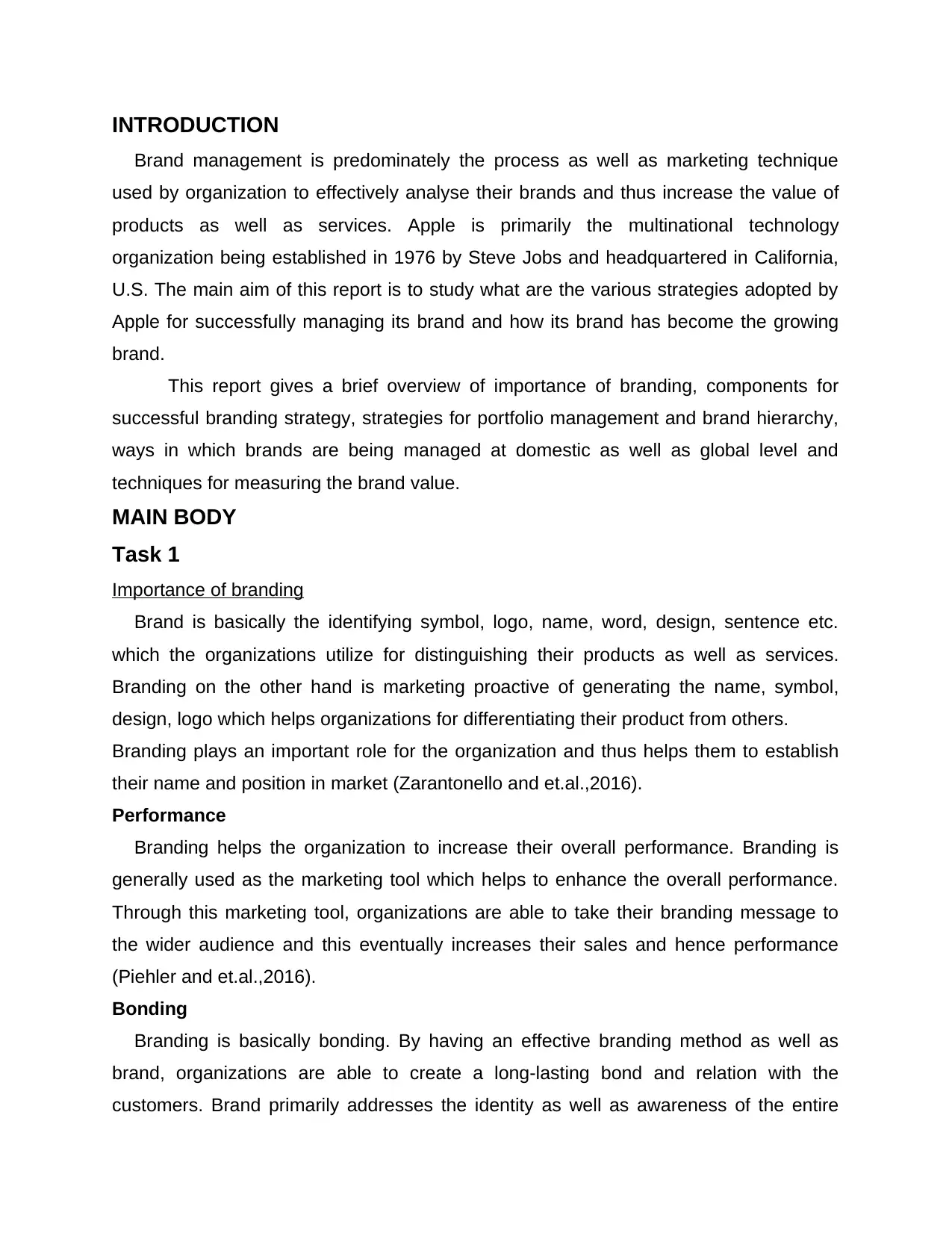
INTRODUCTION
Brand management is predominately the process as well as marketing technique
used by organization to effectively analyse their brands and thus increase the value of
products as well as services. Apple is primarily the multinational technology
organization being established in 1976 by Steve Jobs and headquartered in California,
U.S. The main aim of this report is to study what are the various strategies adopted by
Apple for successfully managing its brand and how its brand has become the growing
brand.
This report gives a brief overview of importance of branding, components for
successful branding strategy, strategies for portfolio management and brand hierarchy,
ways in which brands are being managed at domestic as well as global level and
techniques for measuring the brand value.
MAIN BODY
Task 1
Importance of branding
Brand is basically the identifying symbol, logo, name, word, design, sentence etc.
which the organizations utilize for distinguishing their products as well as services.
Branding on the other hand is marketing proactive of generating the name, symbol,
design, logo which helps organizations for differentiating their product from others.
Branding plays an important role for the organization and thus helps them to establish
their name and position in market (Zarantonello and et.al.,2016).
Performance
Branding helps the organization to increase their overall performance. Branding is
generally used as the marketing tool which helps to enhance the overall performance.
Through this marketing tool, organizations are able to take their branding message to
the wider audience and this eventually increases their sales and hence performance
(Piehler and et.al.,2016).
Bonding
Branding is basically bonding. By having an effective branding method as well as
brand, organizations are able to create a long-lasting bond and relation with the
customers. Brand primarily addresses the identity as well as awareness of the entire
Brand management is predominately the process as well as marketing technique
used by organization to effectively analyse their brands and thus increase the value of
products as well as services. Apple is primarily the multinational technology
organization being established in 1976 by Steve Jobs and headquartered in California,
U.S. The main aim of this report is to study what are the various strategies adopted by
Apple for successfully managing its brand and how its brand has become the growing
brand.
This report gives a brief overview of importance of branding, components for
successful branding strategy, strategies for portfolio management and brand hierarchy,
ways in which brands are being managed at domestic as well as global level and
techniques for measuring the brand value.
MAIN BODY
Task 1
Importance of branding
Brand is basically the identifying symbol, logo, name, word, design, sentence etc.
which the organizations utilize for distinguishing their products as well as services.
Branding on the other hand is marketing proactive of generating the name, symbol,
design, logo which helps organizations for differentiating their product from others.
Branding plays an important role for the organization and thus helps them to establish
their name and position in market (Zarantonello and et.al.,2016).
Performance
Branding helps the organization to increase their overall performance. Branding is
generally used as the marketing tool which helps to enhance the overall performance.
Through this marketing tool, organizations are able to take their branding message to
the wider audience and this eventually increases their sales and hence performance
(Piehler and et.al.,2016).
Bonding
Branding is basically bonding. By having an effective branding method as well as
brand, organizations are able to create a long-lasting bond and relation with the
customers. Brand primarily addresses the identity as well as awareness of the entire
You're viewing a preview
Unlock full access by subscribing today!
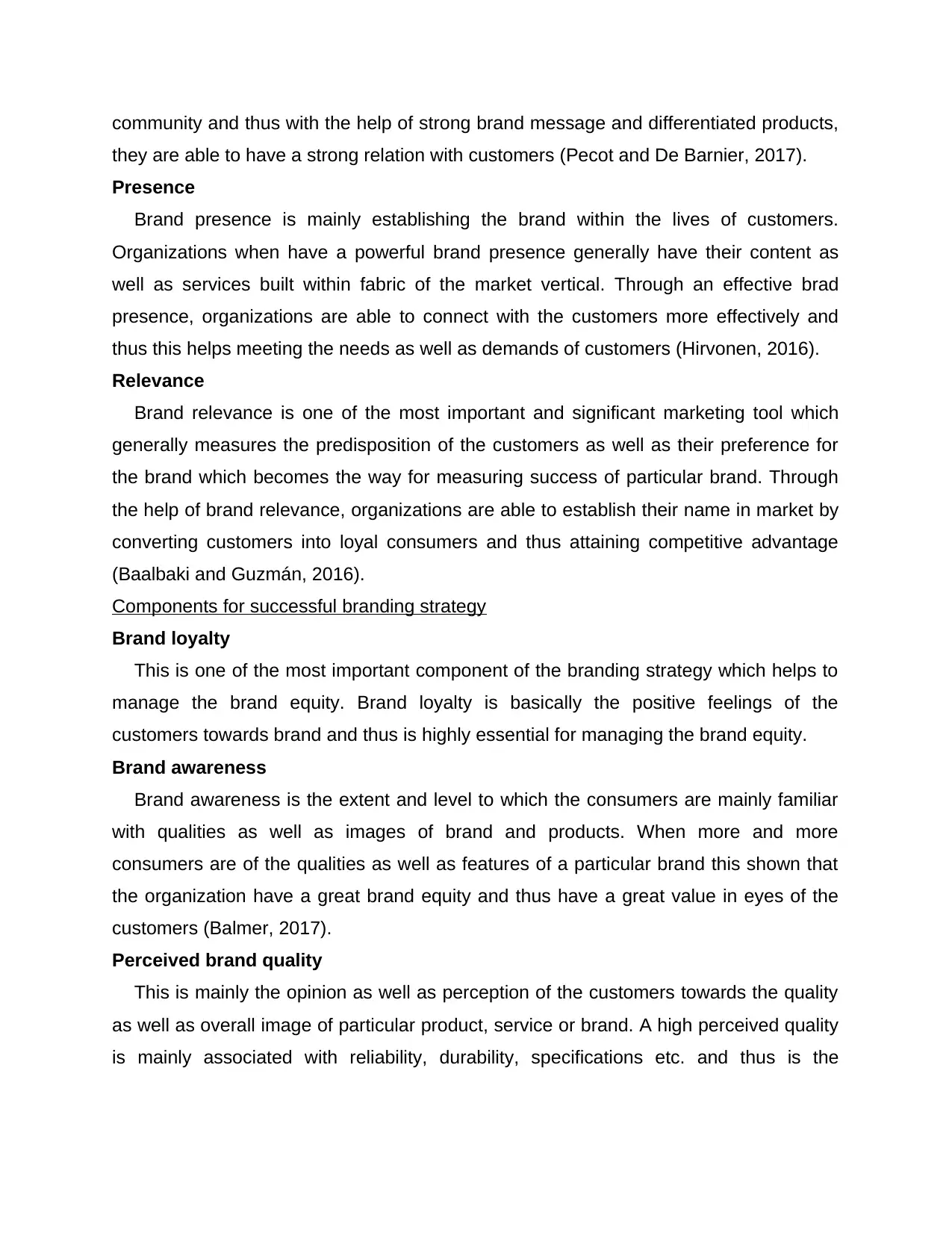
community and thus with the help of strong brand message and differentiated products,
they are able to have a strong relation with customers (Pecot and De Barnier, 2017).
Presence
Brand presence is mainly establishing the brand within the lives of customers.
Organizations when have a powerful brand presence generally have their content as
well as services built within fabric of the market vertical. Through an effective brad
presence, organizations are able to connect with the customers more effectively and
thus this helps meeting the needs as well as demands of customers (Hirvonen, 2016).
Relevance
Brand relevance is one of the most important and significant marketing tool which
generally measures the predisposition of the customers as well as their preference for
the brand which becomes the way for measuring success of particular brand. Through
the help of brand relevance, organizations are able to establish their name in market by
converting customers into loyal consumers and thus attaining competitive advantage
(Baalbaki and Guzmán, 2016).
Components for successful branding strategy
Brand loyalty
This is one of the most important component of the branding strategy which helps to
manage the brand equity. Brand loyalty is basically the positive feelings of the
customers towards brand and thus is highly essential for managing the brand equity.
Brand awareness
Brand awareness is the extent and level to which the consumers are mainly familiar
with qualities as well as images of brand and products. When more and more
consumers are of the qualities as well as features of a particular brand this shown that
the organization have a great brand equity and thus have a great value in eyes of the
customers (Balmer, 2017).
Perceived brand quality
This is mainly the opinion as well as perception of the customers towards the quality
as well as overall image of particular product, service or brand. A high perceived quality
is mainly associated with reliability, durability, specifications etc. and thus is the
they are able to have a strong relation with customers (Pecot and De Barnier, 2017).
Presence
Brand presence is mainly establishing the brand within the lives of customers.
Organizations when have a powerful brand presence generally have their content as
well as services built within fabric of the market vertical. Through an effective brad
presence, organizations are able to connect with the customers more effectively and
thus this helps meeting the needs as well as demands of customers (Hirvonen, 2016).
Relevance
Brand relevance is one of the most important and significant marketing tool which
generally measures the predisposition of the customers as well as their preference for
the brand which becomes the way for measuring success of particular brand. Through
the help of brand relevance, organizations are able to establish their name in market by
converting customers into loyal consumers and thus attaining competitive advantage
(Baalbaki and Guzmán, 2016).
Components for successful branding strategy
Brand loyalty
This is one of the most important component of the branding strategy which helps to
manage the brand equity. Brand loyalty is basically the positive feelings of the
customers towards brand and thus is highly essential for managing the brand equity.
Brand awareness
Brand awareness is the extent and level to which the consumers are mainly familiar
with qualities as well as images of brand and products. When more and more
consumers are of the qualities as well as features of a particular brand this shown that
the organization have a great brand equity and thus have a great value in eyes of the
customers (Balmer, 2017).
Perceived brand quality
This is mainly the opinion as well as perception of the customers towards the quality
as well as overall image of particular product, service or brand. A high perceived quality
is mainly associated with reliability, durability, specifications etc. and thus is the
Paraphrase This Document
Need a fresh take? Get an instant paraphrase of this document with our AI Paraphraser
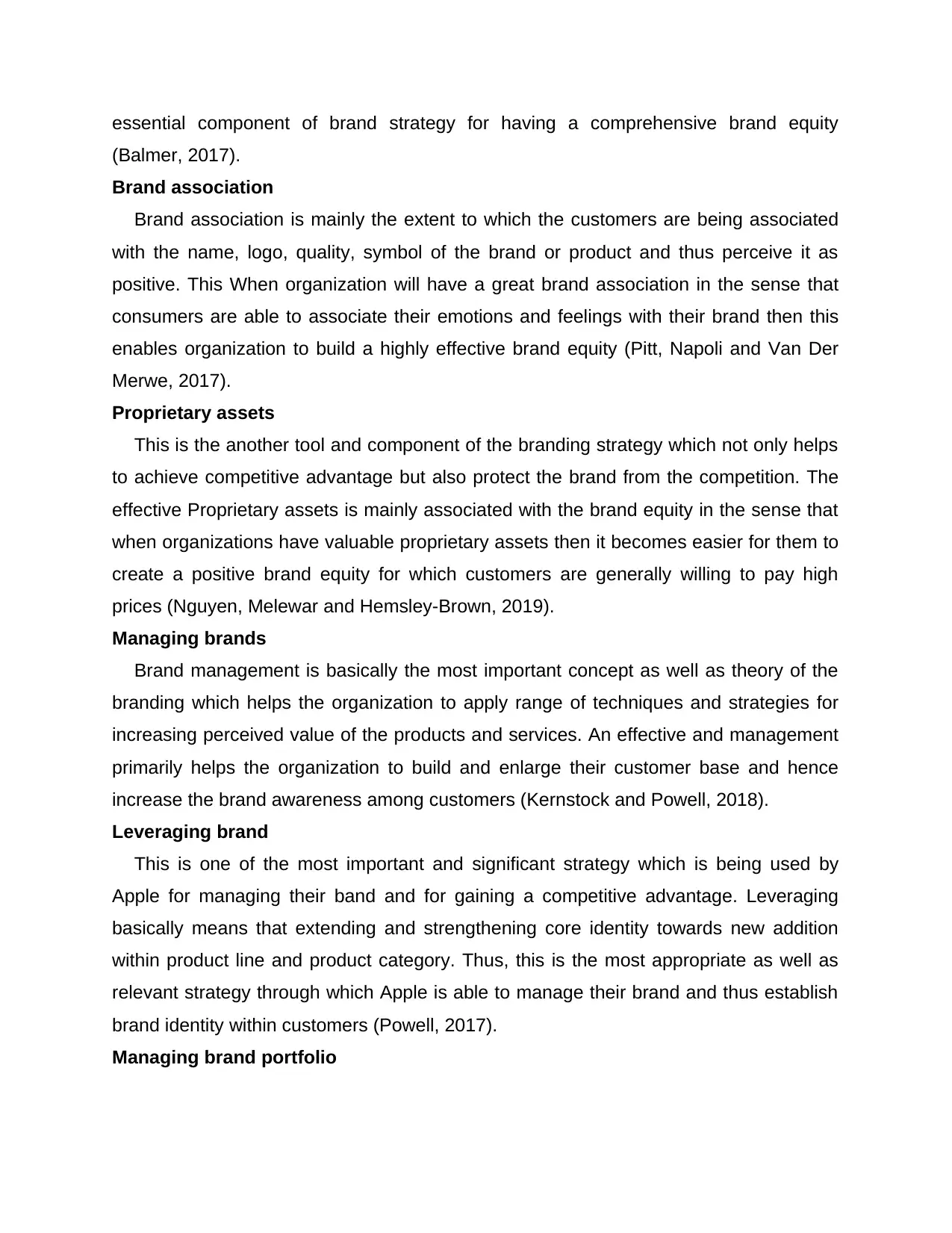
essential component of brand strategy for having a comprehensive brand equity
(Balmer, 2017).
Brand association
Brand association is mainly the extent to which the customers are being associated
with the name, logo, quality, symbol of the brand or product and thus perceive it as
positive. This When organization will have a great brand association in the sense that
consumers are able to associate their emotions and feelings with their brand then this
enables organization to build a highly effective brand equity (Pitt, Napoli and Van Der
Merwe, 2017).
Proprietary assets
This is the another tool and component of the branding strategy which not only helps
to achieve competitive advantage but also protect the brand from the competition. The
effective Proprietary assets is mainly associated with the brand equity in the sense that
when organizations have valuable proprietary assets then it becomes easier for them to
create a positive brand equity for which customers are generally willing to pay high
prices (Nguyen, Melewar and Hemsley-Brown, 2019).
Managing brands
Brand management is basically the most important concept as well as theory of the
branding which helps the organization to apply range of techniques and strategies for
increasing perceived value of the products and services. An effective and management
primarily helps the organization to build and enlarge their customer base and hence
increase the brand awareness among customers (Kernstock and Powell, 2018).
Leveraging brand
This is one of the most important and significant strategy which is being used by
Apple for managing their band and for gaining a competitive advantage. Leveraging
basically means that extending and strengthening core identity towards new addition
within product line and product category. Thus, this is the most appropriate as well as
relevant strategy through which Apple is able to manage their brand and thus establish
brand identity within customers (Powell, 2017).
Managing brand portfolio
(Balmer, 2017).
Brand association
Brand association is mainly the extent to which the customers are being associated
with the name, logo, quality, symbol of the brand or product and thus perceive it as
positive. This When organization will have a great brand association in the sense that
consumers are able to associate their emotions and feelings with their brand then this
enables organization to build a highly effective brand equity (Pitt, Napoli and Van Der
Merwe, 2017).
Proprietary assets
This is the another tool and component of the branding strategy which not only helps
to achieve competitive advantage but also protect the brand from the competition. The
effective Proprietary assets is mainly associated with the brand equity in the sense that
when organizations have valuable proprietary assets then it becomes easier for them to
create a positive brand equity for which customers are generally willing to pay high
prices (Nguyen, Melewar and Hemsley-Brown, 2019).
Managing brands
Brand management is basically the most important concept as well as theory of the
branding which helps the organization to apply range of techniques and strategies for
increasing perceived value of the products and services. An effective and management
primarily helps the organization to build and enlarge their customer base and hence
increase the brand awareness among customers (Kernstock and Powell, 2018).
Leveraging brand
This is one of the most important and significant strategy which is being used by
Apple for managing their band and for gaining a competitive advantage. Leveraging
basically means that extending and strengthening core identity towards new addition
within product line and product category. Thus, this is the most appropriate as well as
relevant strategy through which Apple is able to manage their brand and thus establish
brand identity within customers (Powell, 2017).
Managing brand portfolio
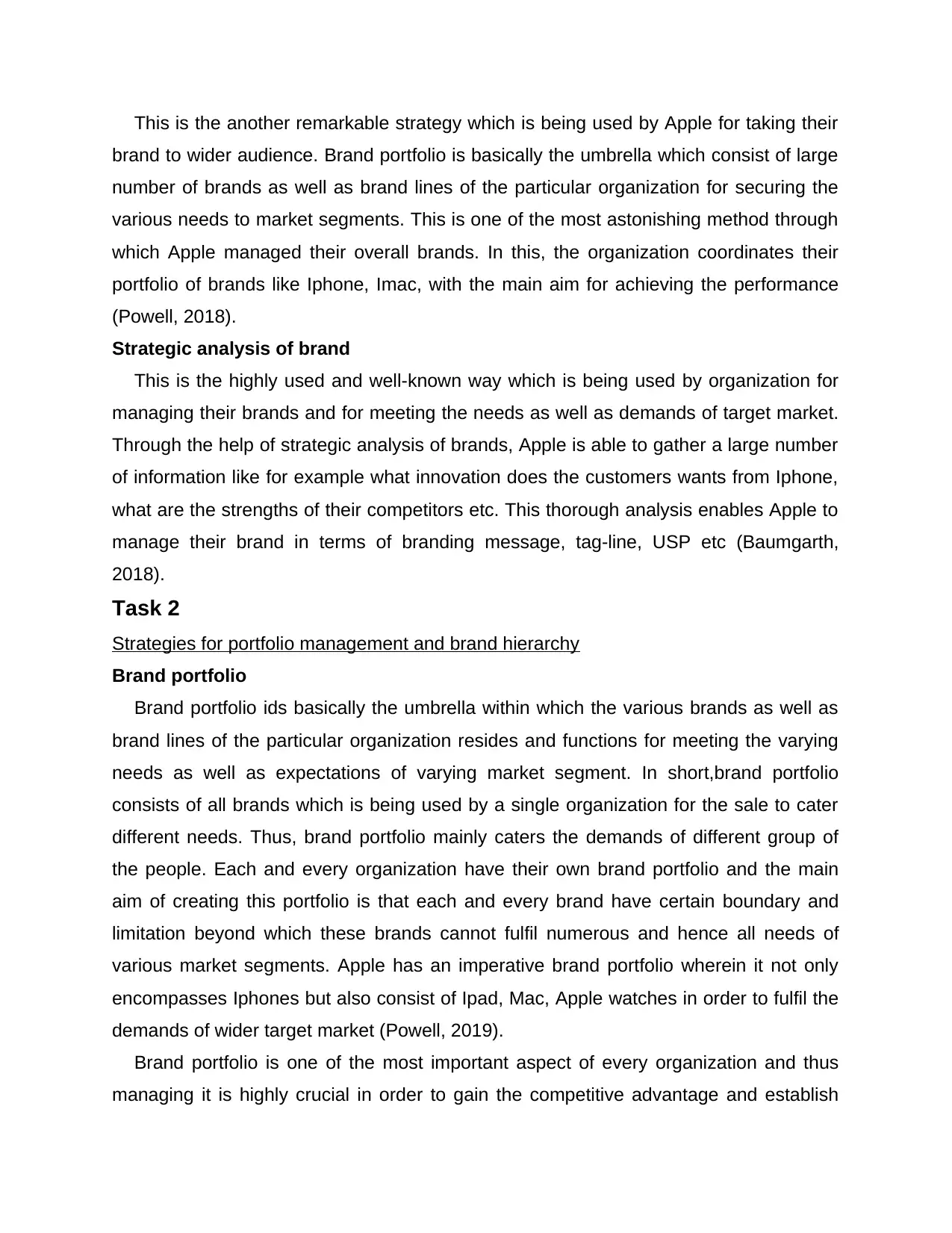
This is the another remarkable strategy which is being used by Apple for taking their
brand to wider audience. Brand portfolio is basically the umbrella which consist of large
number of brands as well as brand lines of the particular organization for securing the
various needs to market segments. This is one of the most astonishing method through
which Apple managed their overall brands. In this, the organization coordinates their
portfolio of brands like Iphone, Imac, with the main aim for achieving the performance
(Powell, 2018).
Strategic analysis of brand
This is the highly used and well-known way which is being used by organization for
managing their brands and for meeting the needs as well as demands of target market.
Through the help of strategic analysis of brands, Apple is able to gather a large number
of information like for example what innovation does the customers wants from Iphone,
what are the strengths of their competitors etc. This thorough analysis enables Apple to
manage their brand in terms of branding message, tag-line, USP etc (Baumgarth,
2018).
Task 2
Strategies for portfolio management and brand hierarchy
Brand portfolio
Brand portfolio ids basically the umbrella within which the various brands as well as
brand lines of the particular organization resides and functions for meeting the varying
needs as well as expectations of varying market segment. In short,brand portfolio
consists of all brands which is being used by a single organization for the sale to cater
different needs. Thus, brand portfolio mainly caters the demands of different group of
the people. Each and every organization have their own brand portfolio and the main
aim of creating this portfolio is that each and every brand have certain boundary and
limitation beyond which these brands cannot fulfil numerous and hence all needs of
various market segments. Apple has an imperative brand portfolio wherein it not only
encompasses Iphones but also consist of Ipad, Mac, Apple watches in order to fulfil the
demands of wider target market (Powell, 2019).
Brand portfolio is one of the most important aspect of every organization and thus
managing it is highly crucial in order to gain the competitive advantage and establish
brand to wider audience. Brand portfolio is basically the umbrella which consist of large
number of brands as well as brand lines of the particular organization for securing the
various needs to market segments. This is one of the most astonishing method through
which Apple managed their overall brands. In this, the organization coordinates their
portfolio of brands like Iphone, Imac, with the main aim for achieving the performance
(Powell, 2018).
Strategic analysis of brand
This is the highly used and well-known way which is being used by organization for
managing their brands and for meeting the needs as well as demands of target market.
Through the help of strategic analysis of brands, Apple is able to gather a large number
of information like for example what innovation does the customers wants from Iphone,
what are the strengths of their competitors etc. This thorough analysis enables Apple to
manage their brand in terms of branding message, tag-line, USP etc (Baumgarth,
2018).
Task 2
Strategies for portfolio management and brand hierarchy
Brand portfolio
Brand portfolio ids basically the umbrella within which the various brands as well as
brand lines of the particular organization resides and functions for meeting the varying
needs as well as expectations of varying market segment. In short,brand portfolio
consists of all brands which is being used by a single organization for the sale to cater
different needs. Thus, brand portfolio mainly caters the demands of different group of
the people. Each and every organization have their own brand portfolio and the main
aim of creating this portfolio is that each and every brand have certain boundary and
limitation beyond which these brands cannot fulfil numerous and hence all needs of
various market segments. Apple has an imperative brand portfolio wherein it not only
encompasses Iphones but also consist of Ipad, Mac, Apple watches in order to fulfil the
demands of wider target market (Powell, 2019).
Brand portfolio is one of the most important aspect of every organization and thus
managing it is highly crucial in order to gain the competitive advantage and establish
You're viewing a preview
Unlock full access by subscribing today!
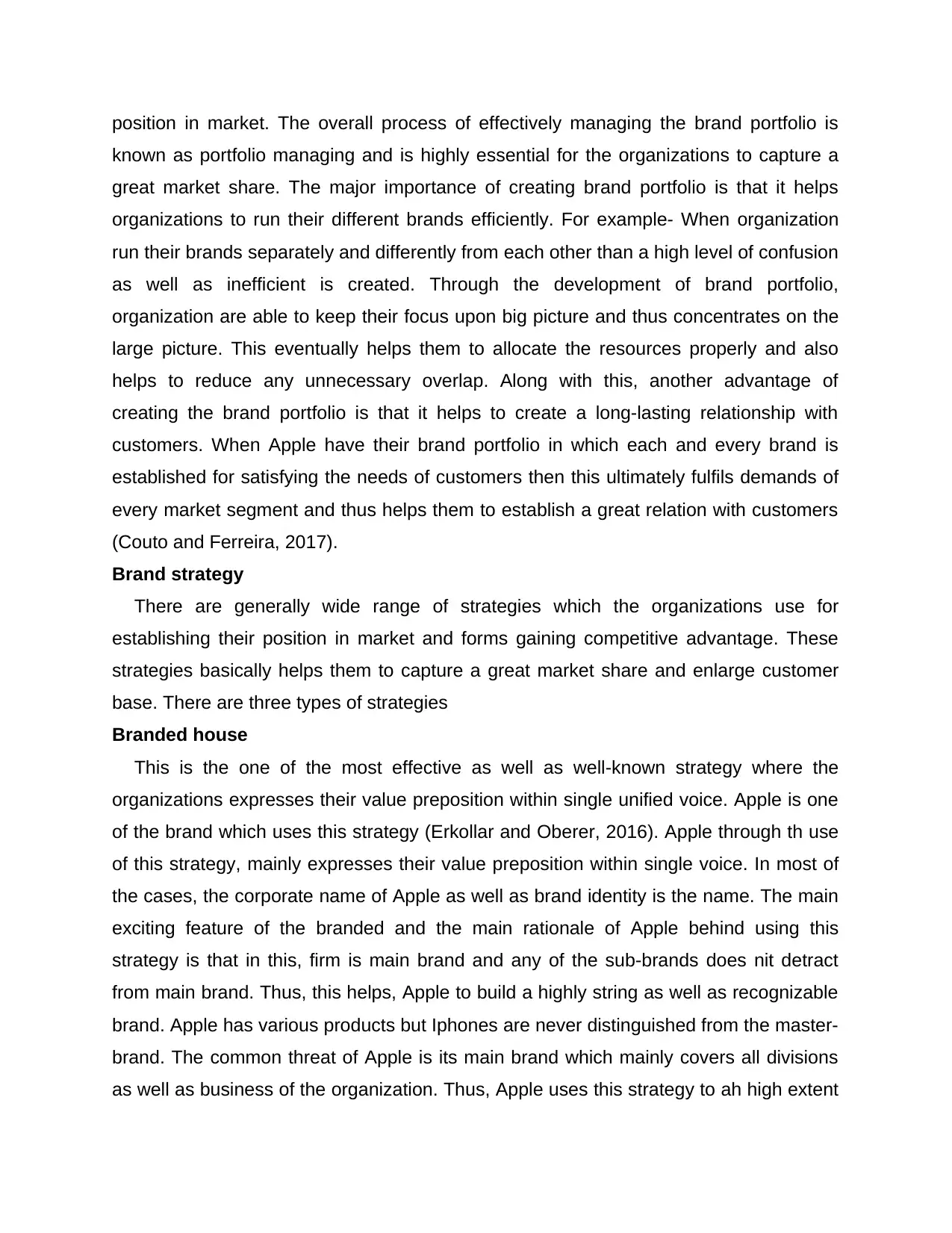
position in market. The overall process of effectively managing the brand portfolio is
known as portfolio managing and is highly essential for the organizations to capture a
great market share. The major importance of creating brand portfolio is that it helps
organizations to run their different brands efficiently. For example- When organization
run their brands separately and differently from each other than a high level of confusion
as well as inefficient is created. Through the development of brand portfolio,
organization are able to keep their focus upon big picture and thus concentrates on the
large picture. This eventually helps them to allocate the resources properly and also
helps to reduce any unnecessary overlap. Along with this, another advantage of
creating the brand portfolio is that it helps to create a long-lasting relationship with
customers. When Apple have their brand portfolio in which each and every brand is
established for satisfying the needs of customers then this ultimately fulfils demands of
every market segment and thus helps them to establish a great relation with customers
(Couto and Ferreira, 2017).
Brand strategy
There are generally wide range of strategies which the organizations use for
establishing their position in market and forms gaining competitive advantage. These
strategies basically helps them to capture a great market share and enlarge customer
base. There are three types of strategies
Branded house
This is the one of the most effective as well as well-known strategy where the
organizations expresses their value preposition within single unified voice. Apple is one
of the brand which uses this strategy (Erkollar and Oberer, 2016). Apple through th use
of this strategy, mainly expresses their value preposition within single voice. In most of
the cases, the corporate name of Apple as well as brand identity is the name. The main
exciting feature of the branded and the main rationale of Apple behind using this
strategy is that in this, firm is main brand and any of the sub-brands does nit detract
from main brand. Thus, this helps, Apple to build a highly string as well as recognizable
brand. Apple has various products but Iphones are never distinguished from the master-
brand. The common threat of Apple is its main brand which mainly covers all divisions
as well as business of the organization. Thus, Apple uses this strategy to ah high extent
known as portfolio managing and is highly essential for the organizations to capture a
great market share. The major importance of creating brand portfolio is that it helps
organizations to run their different brands efficiently. For example- When organization
run their brands separately and differently from each other than a high level of confusion
as well as inefficient is created. Through the development of brand portfolio,
organization are able to keep their focus upon big picture and thus concentrates on the
large picture. This eventually helps them to allocate the resources properly and also
helps to reduce any unnecessary overlap. Along with this, another advantage of
creating the brand portfolio is that it helps to create a long-lasting relationship with
customers. When Apple have their brand portfolio in which each and every brand is
established for satisfying the needs of customers then this ultimately fulfils demands of
every market segment and thus helps them to establish a great relation with customers
(Couto and Ferreira, 2017).
Brand strategy
There are generally wide range of strategies which the organizations use for
establishing their position in market and forms gaining competitive advantage. These
strategies basically helps them to capture a great market share and enlarge customer
base. There are three types of strategies
Branded house
This is the one of the most effective as well as well-known strategy where the
organizations expresses their value preposition within single unified voice. Apple is one
of the brand which uses this strategy (Erkollar and Oberer, 2016). Apple through th use
of this strategy, mainly expresses their value preposition within single voice. In most of
the cases, the corporate name of Apple as well as brand identity is the name. The main
exciting feature of the branded and the main rationale of Apple behind using this
strategy is that in this, firm is main brand and any of the sub-brands does nit detract
from main brand. Thus, this helps, Apple to build a highly string as well as recognizable
brand. Apple has various products but Iphones are never distinguished from the master-
brand. The common threat of Apple is its main brand which mainly covers all divisions
as well as business of the organization. Thus, Apple uses this strategy to ah high extent
Paraphrase This Document
Need a fresh take? Get an instant paraphrase of this document with our AI Paraphraser
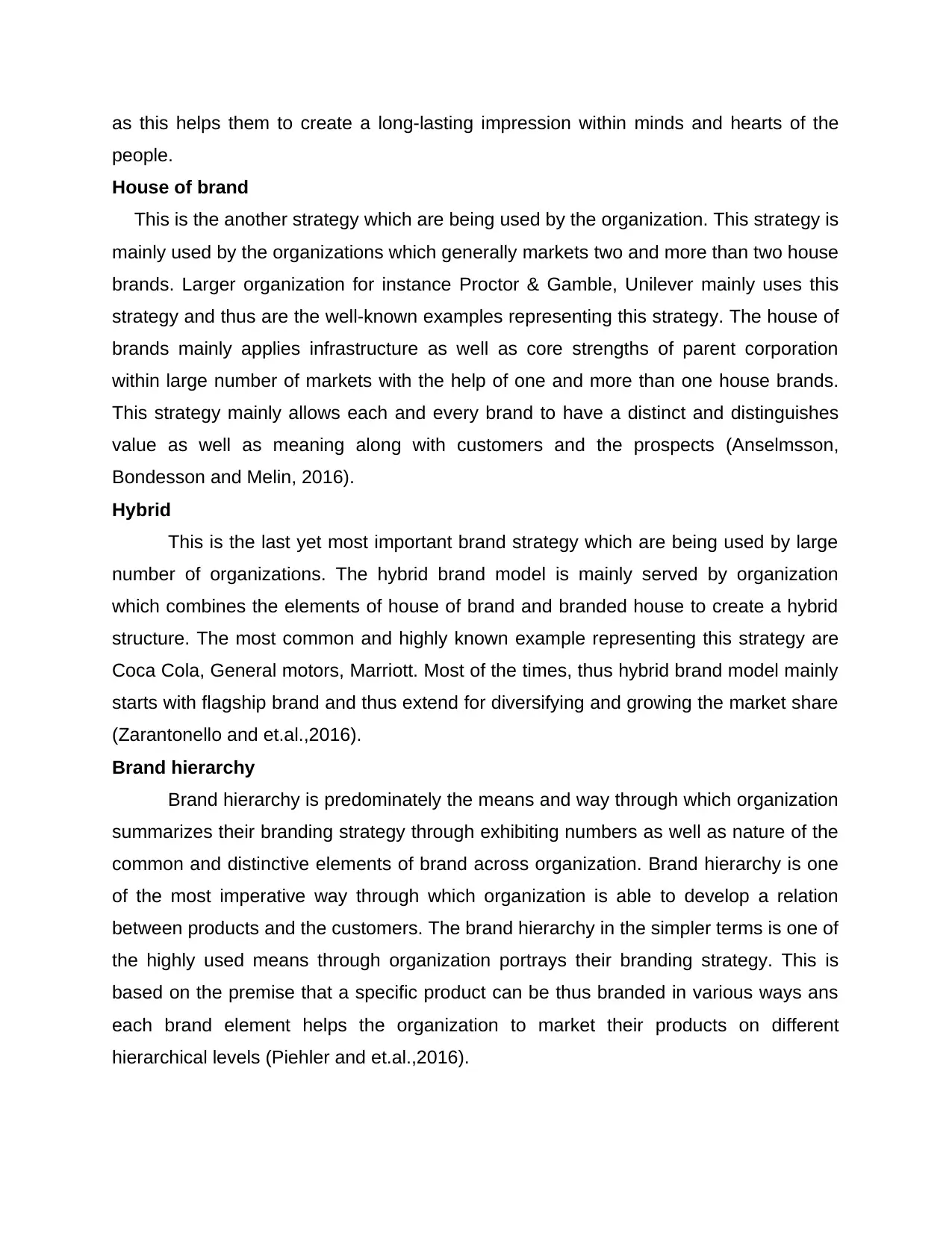
as this helps them to create a long-lasting impression within minds and hearts of the
people.
House of brand
This is the another strategy which are being used by the organization. This strategy is
mainly used by the organizations which generally markets two and more than two house
brands. Larger organization for instance Proctor & Gamble, Unilever mainly uses this
strategy and thus are the well-known examples representing this strategy. The house of
brands mainly applies infrastructure as well as core strengths of parent corporation
within large number of markets with the help of one and more than one house brands.
This strategy mainly allows each and every brand to have a distinct and distinguishes
value as well as meaning along with customers and the prospects (Anselmsson,
Bondesson and Melin, 2016).
Hybrid
This is the last yet most important brand strategy which are being used by large
number of organizations. The hybrid brand model is mainly served by organization
which combines the elements of house of brand and branded house to create a hybrid
structure. The most common and highly known example representing this strategy are
Coca Cola, General motors, Marriott. Most of the times, thus hybrid brand model mainly
starts with flagship brand and thus extend for diversifying and growing the market share
(Zarantonello and et.al.,2016).
Brand hierarchy
Brand hierarchy is predominately the means and way through which organization
summarizes their branding strategy through exhibiting numbers as well as nature of the
common and distinctive elements of brand across organization. Brand hierarchy is one
of the most imperative way through which organization is able to develop a relation
between products and the customers. The brand hierarchy in the simpler terms is one of
the highly used means through organization portrays their branding strategy. This is
based on the premise that a specific product can be thus branded in various ways ans
each brand element helps the organization to market their products on different
hierarchical levels (Piehler and et.al.,2016).
people.
House of brand
This is the another strategy which are being used by the organization. This strategy is
mainly used by the organizations which generally markets two and more than two house
brands. Larger organization for instance Proctor & Gamble, Unilever mainly uses this
strategy and thus are the well-known examples representing this strategy. The house of
brands mainly applies infrastructure as well as core strengths of parent corporation
within large number of markets with the help of one and more than one house brands.
This strategy mainly allows each and every brand to have a distinct and distinguishes
value as well as meaning along with customers and the prospects (Anselmsson,
Bondesson and Melin, 2016).
Hybrid
This is the last yet most important brand strategy which are being used by large
number of organizations. The hybrid brand model is mainly served by organization
which combines the elements of house of brand and branded house to create a hybrid
structure. The most common and highly known example representing this strategy are
Coca Cola, General motors, Marriott. Most of the times, thus hybrid brand model mainly
starts with flagship brand and thus extend for diversifying and growing the market share
(Zarantonello and et.al.,2016).
Brand hierarchy
Brand hierarchy is predominately the means and way through which organization
summarizes their branding strategy through exhibiting numbers as well as nature of the
common and distinctive elements of brand across organization. Brand hierarchy is one
of the most imperative way through which organization is able to develop a relation
between products and the customers. The brand hierarchy in the simpler terms is one of
the highly used means through organization portrays their branding strategy. This is
based on the premise that a specific product can be thus branded in various ways ans
each brand element helps the organization to market their products on different
hierarchical levels (Piehler and et.al.,2016).
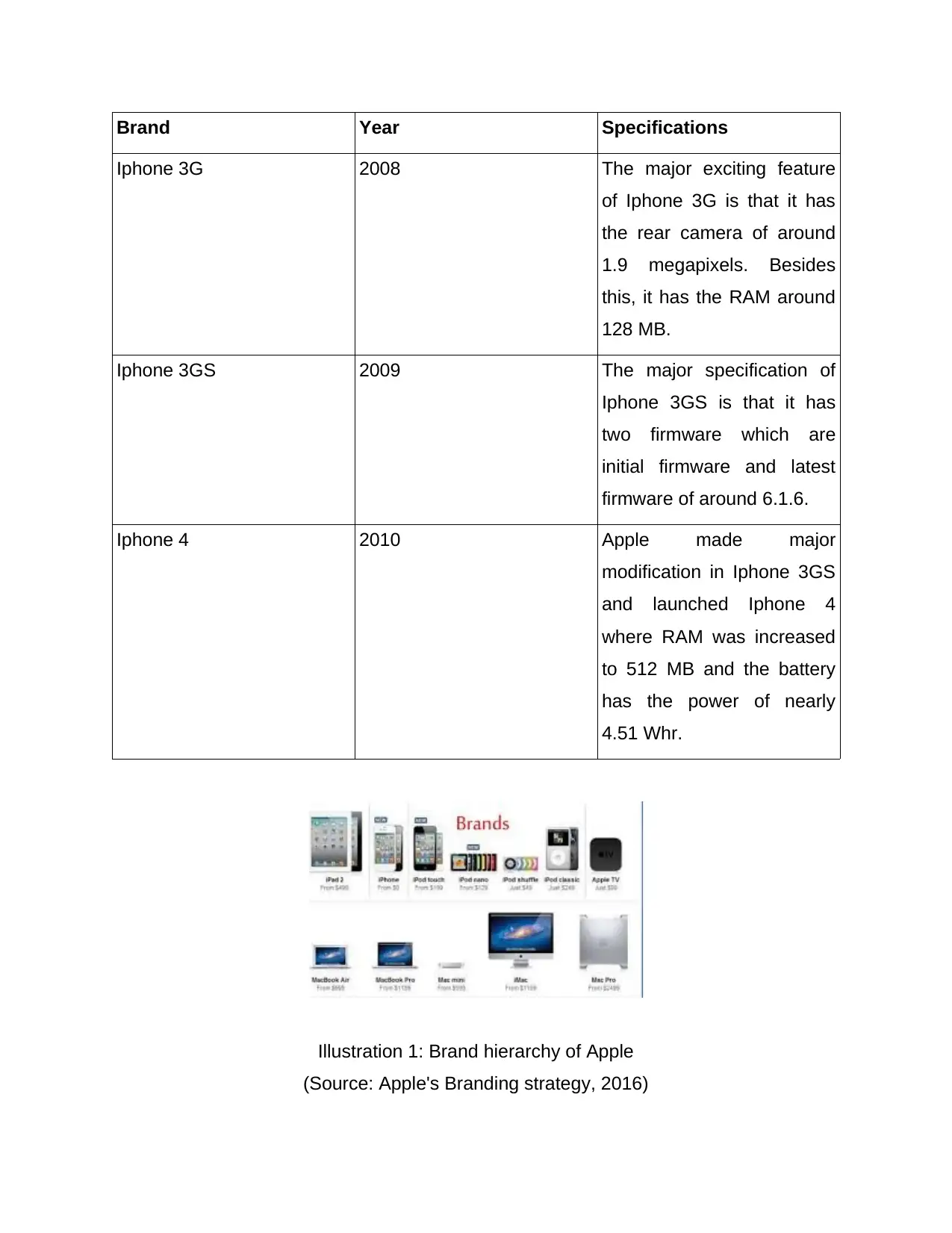
Brand Year Specifications
Iphone 3G 2008 The major exciting feature
of Iphone 3G is that it has
the rear camera of around
1.9 megapixels. Besides
this, it has the RAM around
128 MB.
Iphone 3GS 2009 The major specification of
Iphone 3GS is that it has
two firmware which are
initial firmware and latest
firmware of around 6.1.6.
Iphone 4 2010 Apple made major
modification in Iphone 3GS
and launched Iphone 4
where RAM was increased
to 512 MB and the battery
has the power of nearly
4.51 Whr.
Illustration 1: Brand hierarchy of Apple
(Source: Apple's Branding strategy, 2016)
Iphone 3G 2008 The major exciting feature
of Iphone 3G is that it has
the rear camera of around
1.9 megapixels. Besides
this, it has the RAM around
128 MB.
Iphone 3GS 2009 The major specification of
Iphone 3GS is that it has
two firmware which are
initial firmware and latest
firmware of around 6.1.6.
Iphone 4 2010 Apple made major
modification in Iphone 3GS
and launched Iphone 4
where RAM was increased
to 512 MB and the battery
has the power of nearly
4.51 Whr.
Illustration 1: Brand hierarchy of Apple
(Source: Apple's Branding strategy, 2016)
You're viewing a preview
Unlock full access by subscribing today!
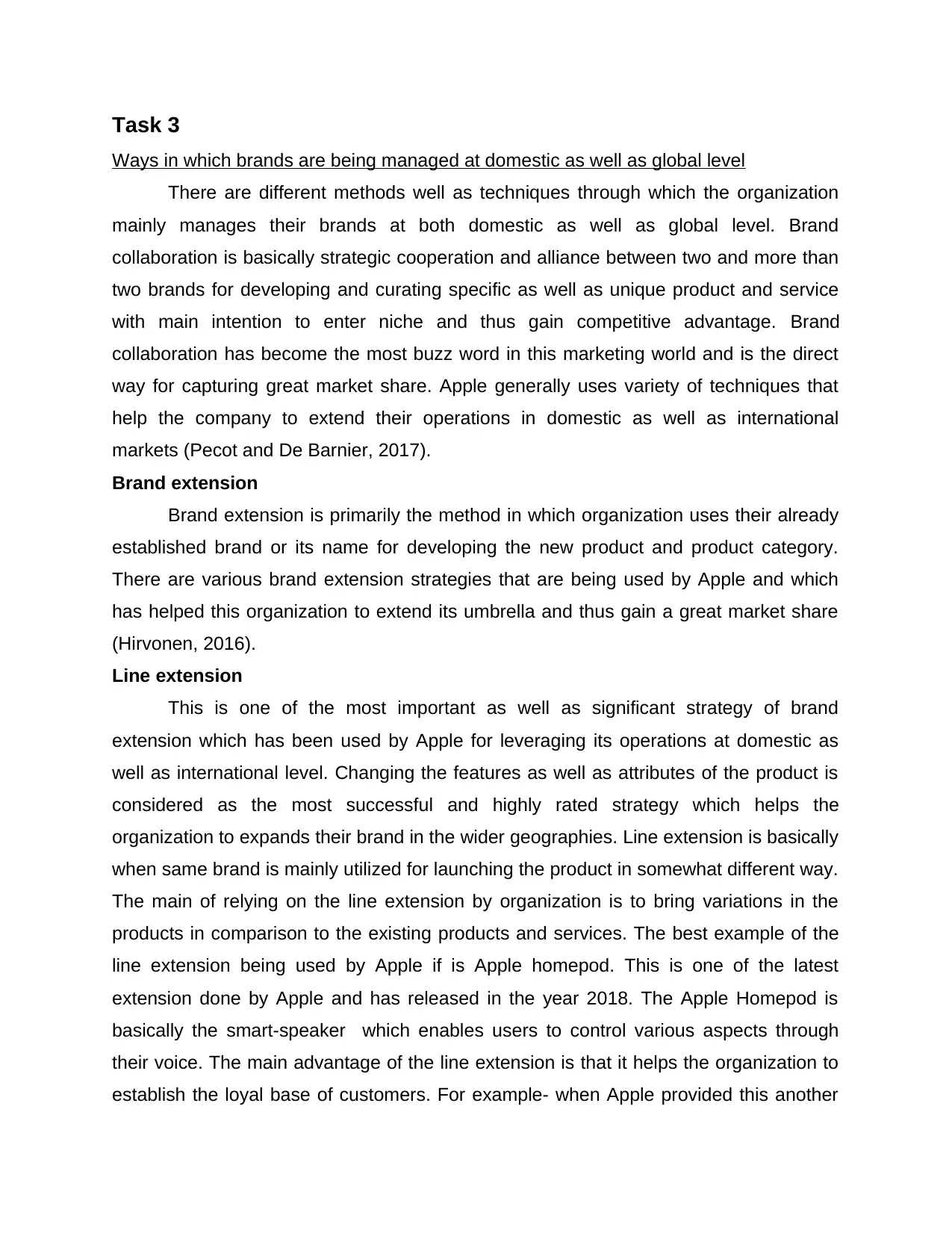
Task 3
Ways in which brands are being managed at domestic as well as global level
There are different methods well as techniques through which the organization
mainly manages their brands at both domestic as well as global level. Brand
collaboration is basically strategic cooperation and alliance between two and more than
two brands for developing and curating specific as well as unique product and service
with main intention to enter niche and thus gain competitive advantage. Brand
collaboration has become the most buzz word in this marketing world and is the direct
way for capturing great market share. Apple generally uses variety of techniques that
help the company to extend their operations in domestic as well as international
markets (Pecot and De Barnier, 2017).
Brand extension
Brand extension is primarily the method in which organization uses their already
established brand or its name for developing the new product and product category.
There are various brand extension strategies that are being used by Apple and which
has helped this organization to extend its umbrella and thus gain a great market share
(Hirvonen, 2016).
Line extension
This is one of the most important as well as significant strategy of brand
extension which has been used by Apple for leveraging its operations at domestic as
well as international level. Changing the features as well as attributes of the product is
considered as the most successful and highly rated strategy which helps the
organization to expands their brand in the wider geographies. Line extension is basically
when same brand is mainly utilized for launching the product in somewhat different way.
The main of relying on the line extension by organization is to bring variations in the
products in comparison to the existing products and services. The best example of the
line extension being used by Apple if is Apple homepod. This is one of the latest
extension done by Apple and has released in the year 2018. The Apple Homepod is
basically the smart-speaker which enables users to control various aspects through
their voice. The main advantage of the line extension is that it helps the organization to
establish the loyal base of customers. For example- when Apple provided this another
Ways in which brands are being managed at domestic as well as global level
There are different methods well as techniques through which the organization
mainly manages their brands at both domestic as well as global level. Brand
collaboration is basically strategic cooperation and alliance between two and more than
two brands for developing and curating specific as well as unique product and service
with main intention to enter niche and thus gain competitive advantage. Brand
collaboration has become the most buzz word in this marketing world and is the direct
way for capturing great market share. Apple generally uses variety of techniques that
help the company to extend their operations in domestic as well as international
markets (Pecot and De Barnier, 2017).
Brand extension
Brand extension is primarily the method in which organization uses their already
established brand or its name for developing the new product and product category.
There are various brand extension strategies that are being used by Apple and which
has helped this organization to extend its umbrella and thus gain a great market share
(Hirvonen, 2016).
Line extension
This is one of the most important as well as significant strategy of brand
extension which has been used by Apple for leveraging its operations at domestic as
well as international level. Changing the features as well as attributes of the product is
considered as the most successful and highly rated strategy which helps the
organization to expands their brand in the wider geographies. Line extension is basically
when same brand is mainly utilized for launching the product in somewhat different way.
The main of relying on the line extension by organization is to bring variations in the
products in comparison to the existing products and services. The best example of the
line extension being used by Apple if is Apple homepod. This is one of the latest
extension done by Apple and has released in the year 2018. The Apple Homepod is
basically the smart-speaker which enables users to control various aspects through
their voice. The main advantage of the line extension is that it helps the organization to
establish the loyal base of customers. For example- when Apple provided this another
Paraphrase This Document
Need a fresh take? Get an instant paraphrase of this document with our AI Paraphraser
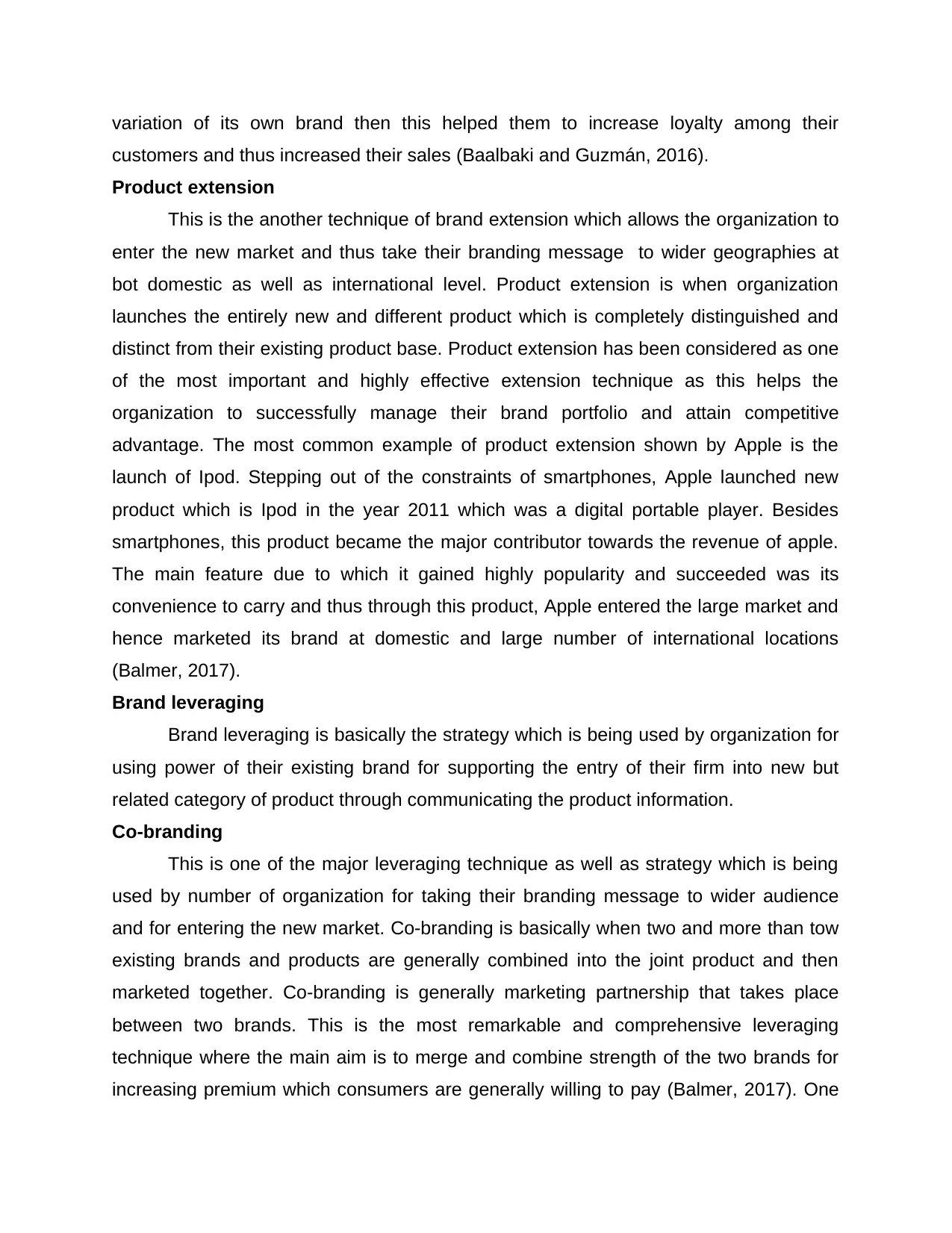
variation of its own brand then this helped them to increase loyalty among their
customers and thus increased their sales (Baalbaki and Guzmán, 2016).
Product extension
This is the another technique of brand extension which allows the organization to
enter the new market and thus take their branding message to wider geographies at
bot domestic as well as international level. Product extension is when organization
launches the entirely new and different product which is completely distinguished and
distinct from their existing product base. Product extension has been considered as one
of the most important and highly effective extension technique as this helps the
organization to successfully manage their brand portfolio and attain competitive
advantage. The most common example of product extension shown by Apple is the
launch of Ipod. Stepping out of the constraints of smartphones, Apple launched new
product which is Ipod in the year 2011 which was a digital portable player. Besides
smartphones, this product became the major contributor towards the revenue of apple.
The main feature due to which it gained highly popularity and succeeded was its
convenience to carry and thus through this product, Apple entered the large market and
hence marketed its brand at domestic and large number of international locations
(Balmer, 2017).
Brand leveraging
Brand leveraging is basically the strategy which is being used by organization for
using power of their existing brand for supporting the entry of their firm into new but
related category of product through communicating the product information.
Co-branding
This is one of the major leveraging technique as well as strategy which is being
used by number of organization for taking their branding message to wider audience
and for entering the new market. Co-branding is basically when two and more than tow
existing brands and products are generally combined into the joint product and then
marketed together. Co-branding is generally marketing partnership that takes place
between two brands. This is the most remarkable and comprehensive leveraging
technique where the main aim is to merge and combine strength of the two brands for
increasing premium which consumers are generally willing to pay (Balmer, 2017). One
customers and thus increased their sales (Baalbaki and Guzmán, 2016).
Product extension
This is the another technique of brand extension which allows the organization to
enter the new market and thus take their branding message to wider geographies at
bot domestic as well as international level. Product extension is when organization
launches the entirely new and different product which is completely distinguished and
distinct from their existing product base. Product extension has been considered as one
of the most important and highly effective extension technique as this helps the
organization to successfully manage their brand portfolio and attain competitive
advantage. The most common example of product extension shown by Apple is the
launch of Ipod. Stepping out of the constraints of smartphones, Apple launched new
product which is Ipod in the year 2011 which was a digital portable player. Besides
smartphones, this product became the major contributor towards the revenue of apple.
The main feature due to which it gained highly popularity and succeeded was its
convenience to carry and thus through this product, Apple entered the large market and
hence marketed its brand at domestic and large number of international locations
(Balmer, 2017).
Brand leveraging
Brand leveraging is basically the strategy which is being used by organization for
using power of their existing brand for supporting the entry of their firm into new but
related category of product through communicating the product information.
Co-branding
This is one of the major leveraging technique as well as strategy which is being
used by number of organization for taking their branding message to wider audience
and for entering the new market. Co-branding is basically when two and more than tow
existing brands and products are generally combined into the joint product and then
marketed together. Co-branding is generally marketing partnership that takes place
between two brands. This is the most remarkable and comprehensive leveraging
technique where the main aim is to merge and combine strength of the two brands for
increasing premium which consumers are generally willing to pay (Balmer, 2017). One
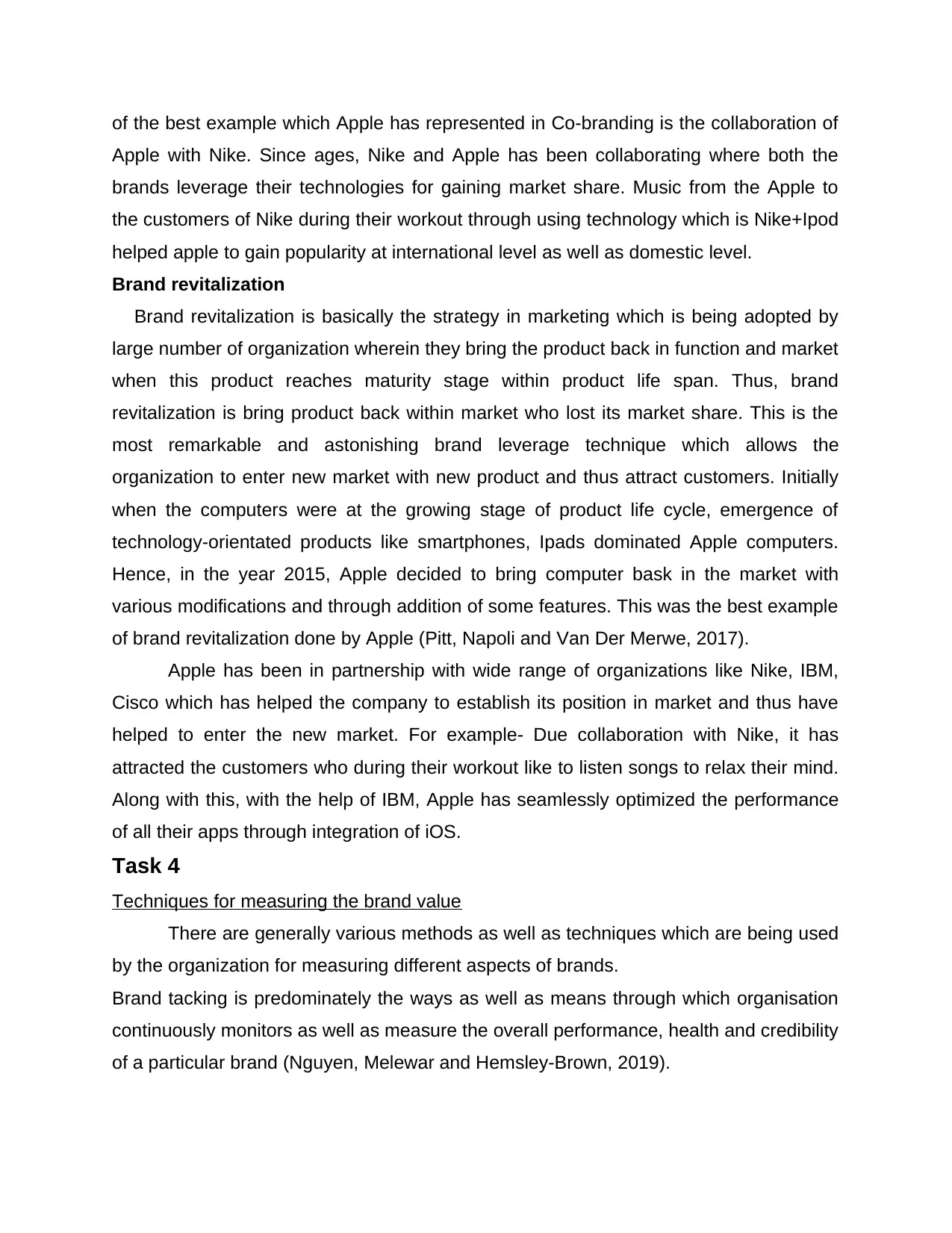
of the best example which Apple has represented in Co-branding is the collaboration of
Apple with Nike. Since ages, Nike and Apple has been collaborating where both the
brands leverage their technologies for gaining market share. Music from the Apple to
the customers of Nike during their workout through using technology which is Nike+Ipod
helped apple to gain popularity at international level as well as domestic level.
Brand revitalization
Brand revitalization is basically the strategy in marketing which is being adopted by
large number of organization wherein they bring the product back in function and market
when this product reaches maturity stage within product life span. Thus, brand
revitalization is bring product back within market who lost its market share. This is the
most remarkable and astonishing brand leverage technique which allows the
organization to enter new market with new product and thus attract customers. Initially
when the computers were at the growing stage of product life cycle, emergence of
technology-orientated products like smartphones, Ipads dominated Apple computers.
Hence, in the year 2015, Apple decided to bring computer bask in the market with
various modifications and through addition of some features. This was the best example
of brand revitalization done by Apple (Pitt, Napoli and Van Der Merwe, 2017).
Apple has been in partnership with wide range of organizations like Nike, IBM,
Cisco which has helped the company to establish its position in market and thus have
helped to enter the new market. For example- Due collaboration with Nike, it has
attracted the customers who during their workout like to listen songs to relax their mind.
Along with this, with the help of IBM, Apple has seamlessly optimized the performance
of all their apps through integration of iOS.
Task 4
Techniques for measuring the brand value
There are generally various methods as well as techniques which are being used
by the organization for measuring different aspects of brands.
Brand tacking is predominately the ways as well as means through which organisation
continuously monitors as well as measure the overall performance, health and credibility
of a particular brand (Nguyen, Melewar and Hemsley-Brown, 2019).
Apple with Nike. Since ages, Nike and Apple has been collaborating where both the
brands leverage their technologies for gaining market share. Music from the Apple to
the customers of Nike during their workout through using technology which is Nike+Ipod
helped apple to gain popularity at international level as well as domestic level.
Brand revitalization
Brand revitalization is basically the strategy in marketing which is being adopted by
large number of organization wherein they bring the product back in function and market
when this product reaches maturity stage within product life span. Thus, brand
revitalization is bring product back within market who lost its market share. This is the
most remarkable and astonishing brand leverage technique which allows the
organization to enter new market with new product and thus attract customers. Initially
when the computers were at the growing stage of product life cycle, emergence of
technology-orientated products like smartphones, Ipads dominated Apple computers.
Hence, in the year 2015, Apple decided to bring computer bask in the market with
various modifications and through addition of some features. This was the best example
of brand revitalization done by Apple (Pitt, Napoli and Van Der Merwe, 2017).
Apple has been in partnership with wide range of organizations like Nike, IBM,
Cisco which has helped the company to establish its position in market and thus have
helped to enter the new market. For example- Due collaboration with Nike, it has
attracted the customers who during their workout like to listen songs to relax their mind.
Along with this, with the help of IBM, Apple has seamlessly optimized the performance
of all their apps through integration of iOS.
Task 4
Techniques for measuring the brand value
There are generally various methods as well as techniques which are being used
by the organization for measuring different aspects of brands.
Brand tacking is predominately the ways as well as means through which organisation
continuously monitors as well as measure the overall performance, health and credibility
of a particular brand (Nguyen, Melewar and Hemsley-Brown, 2019).
You're viewing a preview
Unlock full access by subscribing today!
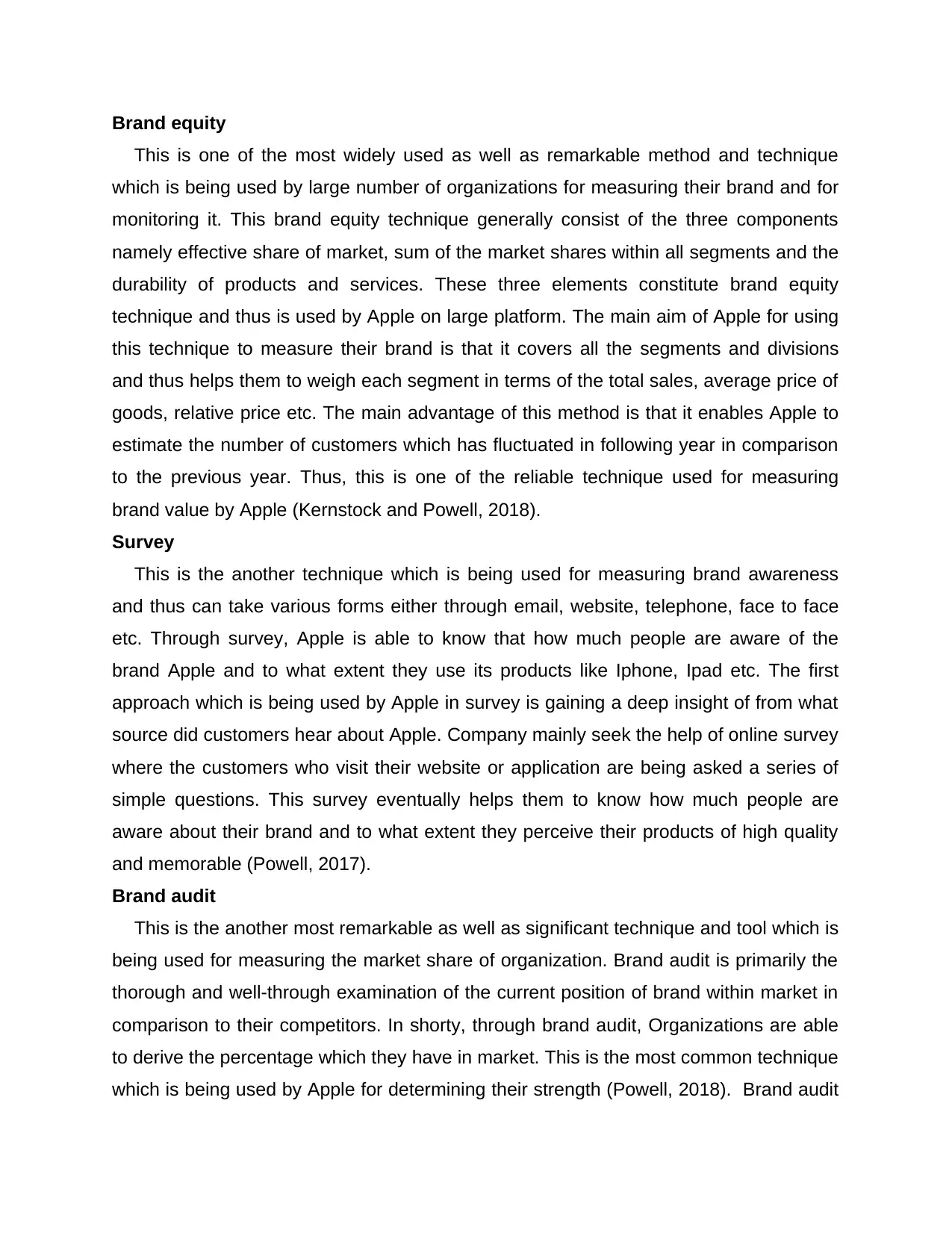
Brand equity
This is one of the most widely used as well as remarkable method and technique
which is being used by large number of organizations for measuring their brand and for
monitoring it. This brand equity technique generally consist of the three components
namely effective share of market, sum of the market shares within all segments and the
durability of products and services. These three elements constitute brand equity
technique and thus is used by Apple on large platform. The main aim of Apple for using
this technique to measure their brand is that it covers all the segments and divisions
and thus helps them to weigh each segment in terms of the total sales, average price of
goods, relative price etc. The main advantage of this method is that it enables Apple to
estimate the number of customers which has fluctuated in following year in comparison
to the previous year. Thus, this is one of the reliable technique used for measuring
brand value by Apple (Kernstock and Powell, 2018).
Survey
This is the another technique which is being used for measuring brand awareness
and thus can take various forms either through email, website, telephone, face to face
etc. Through survey, Apple is able to know that how much people are aware of the
brand Apple and to what extent they use its products like Iphone, Ipad etc. The first
approach which is being used by Apple in survey is gaining a deep insight of from what
source did customers hear about Apple. Company mainly seek the help of online survey
where the customers who visit their website or application are being asked a series of
simple questions. This survey eventually helps them to know how much people are
aware about their brand and to what extent they perceive their products of high quality
and memorable (Powell, 2017).
Brand audit
This is the another most remarkable as well as significant technique and tool which is
being used for measuring the market share of organization. Brand audit is primarily the
thorough and well-through examination of the current position of brand within market in
comparison to their competitors. In shorty, through brand audit, Organizations are able
to derive the percentage which they have in market. This is the most common technique
which is being used by Apple for determining their strength (Powell, 2018). Brand audit
This is one of the most widely used as well as remarkable method and technique
which is being used by large number of organizations for measuring their brand and for
monitoring it. This brand equity technique generally consist of the three components
namely effective share of market, sum of the market shares within all segments and the
durability of products and services. These three elements constitute brand equity
technique and thus is used by Apple on large platform. The main aim of Apple for using
this technique to measure their brand is that it covers all the segments and divisions
and thus helps them to weigh each segment in terms of the total sales, average price of
goods, relative price etc. The main advantage of this method is that it enables Apple to
estimate the number of customers which has fluctuated in following year in comparison
to the previous year. Thus, this is one of the reliable technique used for measuring
brand value by Apple (Kernstock and Powell, 2018).
Survey
This is the another technique which is being used for measuring brand awareness
and thus can take various forms either through email, website, telephone, face to face
etc. Through survey, Apple is able to know that how much people are aware of the
brand Apple and to what extent they use its products like Iphone, Ipad etc. The first
approach which is being used by Apple in survey is gaining a deep insight of from what
source did customers hear about Apple. Company mainly seek the help of online survey
where the customers who visit their website or application are being asked a series of
simple questions. This survey eventually helps them to know how much people are
aware about their brand and to what extent they perceive their products of high quality
and memorable (Powell, 2017).
Brand audit
This is the another most remarkable as well as significant technique and tool which is
being used for measuring the market share of organization. Brand audit is primarily the
thorough and well-through examination of the current position of brand within market in
comparison to their competitors. In shorty, through brand audit, Organizations are able
to derive the percentage which they have in market. This is the most common technique
which is being used by Apple for determining their strength (Powell, 2018). Brand audit
Paraphrase This Document
Need a fresh take? Get an instant paraphrase of this document with our AI Paraphraser
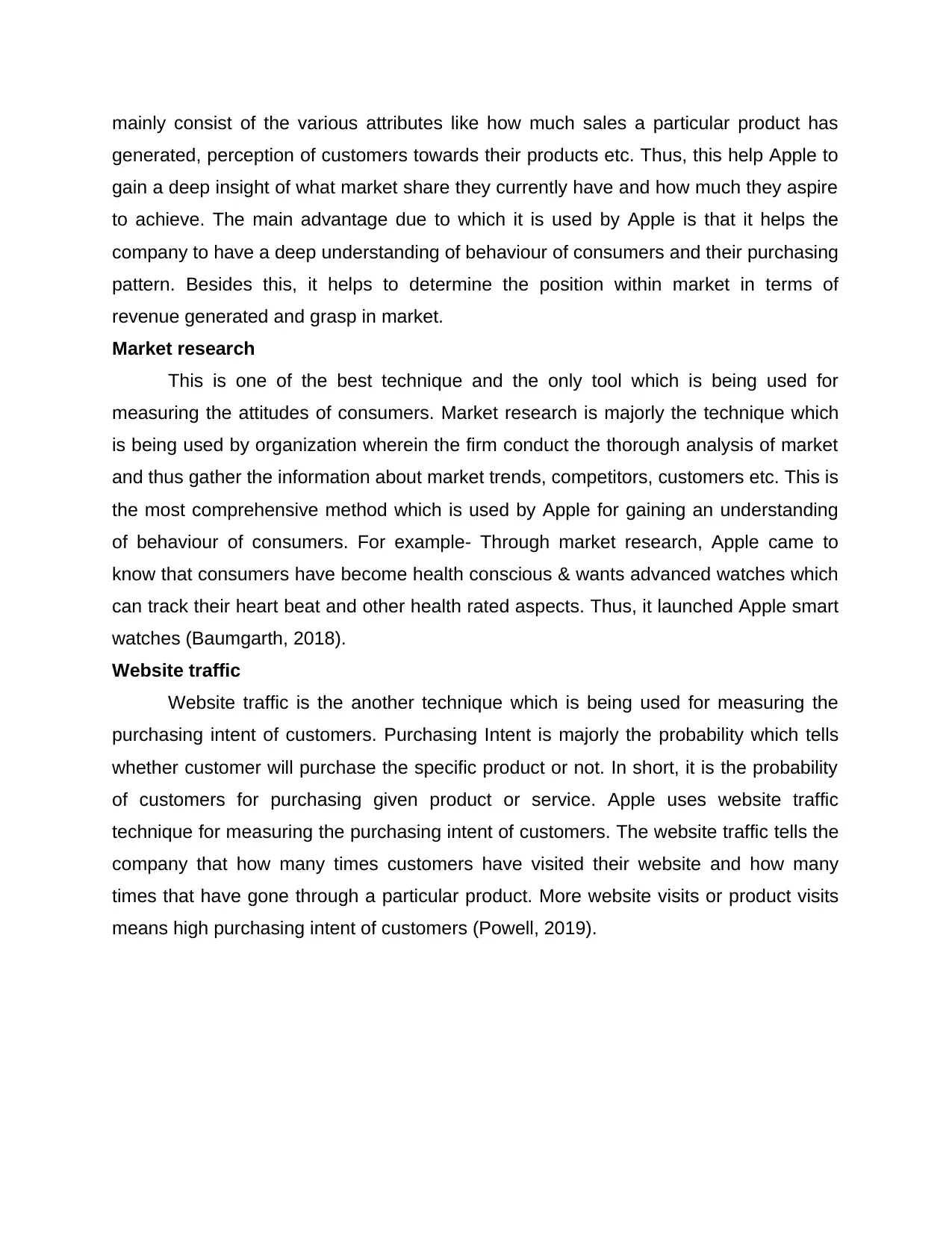
mainly consist of the various attributes like how much sales a particular product has
generated, perception of customers towards their products etc. Thus, this help Apple to
gain a deep insight of what market share they currently have and how much they aspire
to achieve. The main advantage due to which it is used by Apple is that it helps the
company to have a deep understanding of behaviour of consumers and their purchasing
pattern. Besides this, it helps to determine the position within market in terms of
revenue generated and grasp in market.
Market research
This is one of the best technique and the only tool which is being used for
measuring the attitudes of consumers. Market research is majorly the technique which
is being used by organization wherein the firm conduct the thorough analysis of market
and thus gather the information about market trends, competitors, customers etc. This is
the most comprehensive method which is used by Apple for gaining an understanding
of behaviour of consumers. For example- Through market research, Apple came to
know that consumers have become health conscious & wants advanced watches which
can track their heart beat and other health rated aspects. Thus, it launched Apple smart
watches (Baumgarth, 2018).
Website traffic
Website traffic is the another technique which is being used for measuring the
purchasing intent of customers. Purchasing Intent is majorly the probability which tells
whether customer will purchase the specific product or not. In short, it is the probability
of customers for purchasing given product or service. Apple uses website traffic
technique for measuring the purchasing intent of customers. The website traffic tells the
company that how many times customers have visited their website and how many
times that have gone through a particular product. More website visits or product visits
means high purchasing intent of customers (Powell, 2019).
generated, perception of customers towards their products etc. Thus, this help Apple to
gain a deep insight of what market share they currently have and how much they aspire
to achieve. The main advantage due to which it is used by Apple is that it helps the
company to have a deep understanding of behaviour of consumers and their purchasing
pattern. Besides this, it helps to determine the position within market in terms of
revenue generated and grasp in market.
Market research
This is one of the best technique and the only tool which is being used for
measuring the attitudes of consumers. Market research is majorly the technique which
is being used by organization wherein the firm conduct the thorough analysis of market
and thus gather the information about market trends, competitors, customers etc. This is
the most comprehensive method which is used by Apple for gaining an understanding
of behaviour of consumers. For example- Through market research, Apple came to
know that consumers have become health conscious & wants advanced watches which
can track their heart beat and other health rated aspects. Thus, it launched Apple smart
watches (Baumgarth, 2018).
Website traffic
Website traffic is the another technique which is being used for measuring the
purchasing intent of customers. Purchasing Intent is majorly the probability which tells
whether customer will purchase the specific product or not. In short, it is the probability
of customers for purchasing given product or service. Apple uses website traffic
technique for measuring the purchasing intent of customers. The website traffic tells the
company that how many times customers have visited their website and how many
times that have gone through a particular product. More website visits or product visits
means high purchasing intent of customers (Powell, 2019).
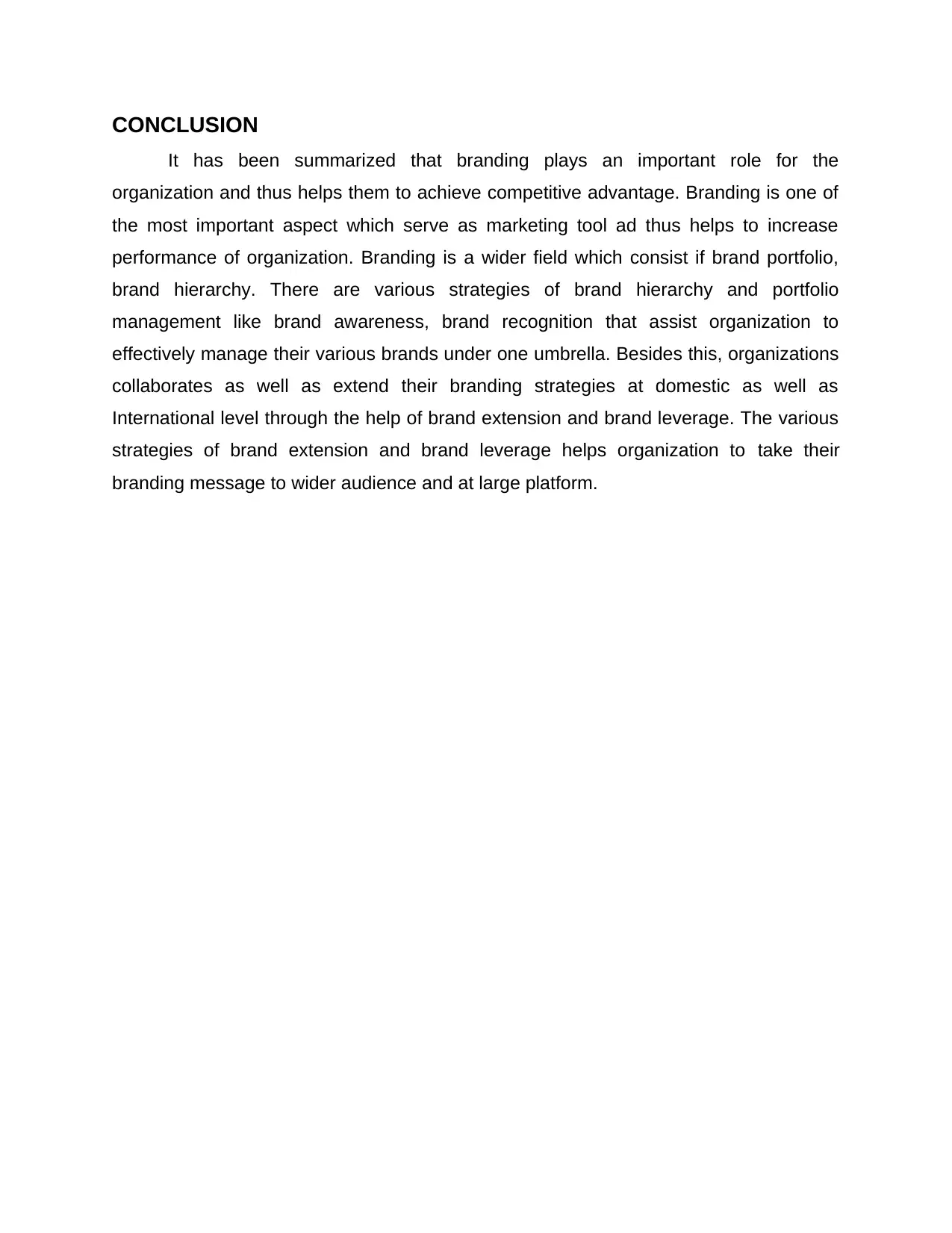
CONCLUSION
It has been summarized that branding plays an important role for the
organization and thus helps them to achieve competitive advantage. Branding is one of
the most important aspect which serve as marketing tool ad thus helps to increase
performance of organization. Branding is a wider field which consist if brand portfolio,
brand hierarchy. There are various strategies of brand hierarchy and portfolio
management like brand awareness, brand recognition that assist organization to
effectively manage their various brands under one umbrella. Besides this, organizations
collaborates as well as extend their branding strategies at domestic as well as
International level through the help of brand extension and brand leverage. The various
strategies of brand extension and brand leverage helps organization to take their
branding message to wider audience and at large platform.
It has been summarized that branding plays an important role for the
organization and thus helps them to achieve competitive advantage. Branding is one of
the most important aspect which serve as marketing tool ad thus helps to increase
performance of organization. Branding is a wider field which consist if brand portfolio,
brand hierarchy. There are various strategies of brand hierarchy and portfolio
management like brand awareness, brand recognition that assist organization to
effectively manage their various brands under one umbrella. Besides this, organizations
collaborates as well as extend their branding strategies at domestic as well as
International level through the help of brand extension and brand leverage. The various
strategies of brand extension and brand leverage helps organization to take their
branding message to wider audience and at large platform.
You're viewing a preview
Unlock full access by subscribing today!
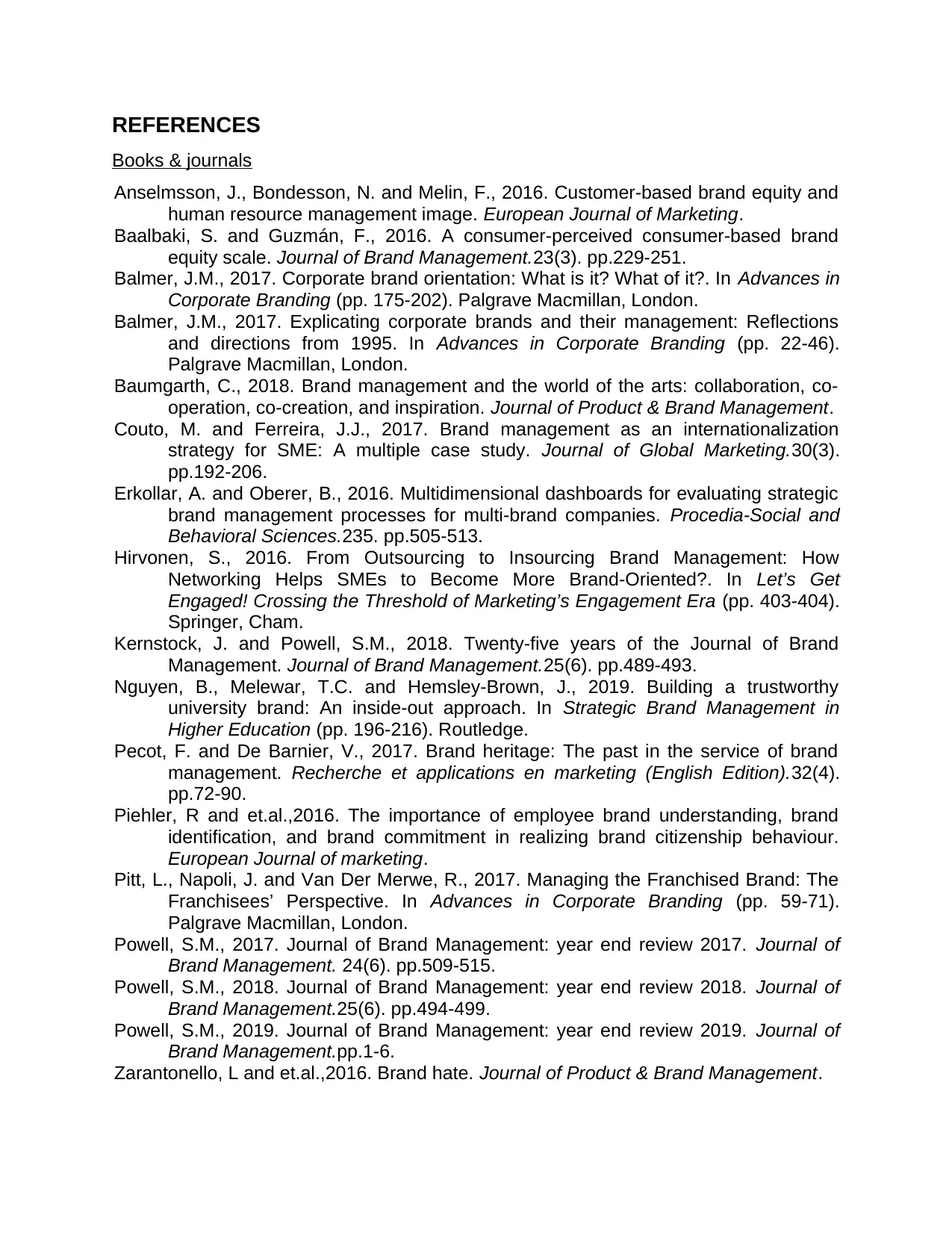
REFERENCES
Books & journals
Anselmsson, J., Bondesson, N. and Melin, F., 2016. Customer-based brand equity and
human resource management image. European Journal of Marketing.
Baalbaki, S. and Guzmán, F., 2016. A consumer-perceived consumer-based brand
equity scale. Journal of Brand Management.23(3). pp.229-251.
Balmer, J.M., 2017. Corporate brand orientation: What is it? What of it?. In Advances in
Corporate Branding (pp. 175-202). Palgrave Macmillan, London.
Balmer, J.M., 2017. Explicating corporate brands and their management: Reflections
and directions from 1995. In Advances in Corporate Branding (pp. 22-46).
Palgrave Macmillan, London.
Baumgarth, C., 2018. Brand management and the world of the arts: collaboration, co-
operation, co-creation, and inspiration. Journal of Product & Brand Management.
Couto, M. and Ferreira, J.J., 2017. Brand management as an internationalization
strategy for SME: A multiple case study. Journal of Global Marketing.30(3).
pp.192-206.
Erkollar, A. and Oberer, B., 2016. Multidimensional dashboards for evaluating strategic
brand management processes for multi-brand companies. Procedia-Social and
Behavioral Sciences.235. pp.505-513.
Hirvonen, S., 2016. From Outsourcing to Insourcing Brand Management: How
Networking Helps SMEs to Become More Brand-Oriented?. In Let’s Get
Engaged! Crossing the Threshold of Marketing’s Engagement Era (pp. 403-404).
Springer, Cham.
Kernstock, J. and Powell, S.M., 2018. Twenty-five years of the Journal of Brand
Management. Journal of Brand Management.25(6). pp.489-493.
Nguyen, B., Melewar, T.C. and Hemsley-Brown, J., 2019. Building a trustworthy
university brand: An inside-out approach. In Strategic Brand Management in
Higher Education (pp. 196-216). Routledge.
Pecot, F. and De Barnier, V., 2017. Brand heritage: The past in the service of brand
management. Recherche et applications en marketing (English Edition).32(4).
pp.72-90.
Piehler, R and et.al.,2016. The importance of employee brand understanding, brand
identification, and brand commitment in realizing brand citizenship behaviour.
European Journal of marketing.
Pitt, L., Napoli, J. and Van Der Merwe, R., 2017. Managing the Franchised Brand: The
Franchisees’ Perspective. In Advances in Corporate Branding (pp. 59-71).
Palgrave Macmillan, London.
Powell, S.M., 2017. Journal of Brand Management: year end review 2017. Journal of
Brand Management. 24(6). pp.509-515.
Powell, S.M., 2018. Journal of Brand Management: year end review 2018. Journal of
Brand Management.25(6). pp.494-499.
Powell, S.M., 2019. Journal of Brand Management: year end review 2019. Journal of
Brand Management.pp.1-6.
Zarantonello, L and et.al.,2016. Brand hate. Journal of Product & Brand Management.
Books & journals
Anselmsson, J., Bondesson, N. and Melin, F., 2016. Customer-based brand equity and
human resource management image. European Journal of Marketing.
Baalbaki, S. and Guzmán, F., 2016. A consumer-perceived consumer-based brand
equity scale. Journal of Brand Management.23(3). pp.229-251.
Balmer, J.M., 2017. Corporate brand orientation: What is it? What of it?. In Advances in
Corporate Branding (pp. 175-202). Palgrave Macmillan, London.
Balmer, J.M., 2017. Explicating corporate brands and their management: Reflections
and directions from 1995. In Advances in Corporate Branding (pp. 22-46).
Palgrave Macmillan, London.
Baumgarth, C., 2018. Brand management and the world of the arts: collaboration, co-
operation, co-creation, and inspiration. Journal of Product & Brand Management.
Couto, M. and Ferreira, J.J., 2017. Brand management as an internationalization
strategy for SME: A multiple case study. Journal of Global Marketing.30(3).
pp.192-206.
Erkollar, A. and Oberer, B., 2016. Multidimensional dashboards for evaluating strategic
brand management processes for multi-brand companies. Procedia-Social and
Behavioral Sciences.235. pp.505-513.
Hirvonen, S., 2016. From Outsourcing to Insourcing Brand Management: How
Networking Helps SMEs to Become More Brand-Oriented?. In Let’s Get
Engaged! Crossing the Threshold of Marketing’s Engagement Era (pp. 403-404).
Springer, Cham.
Kernstock, J. and Powell, S.M., 2018. Twenty-five years of the Journal of Brand
Management. Journal of Brand Management.25(6). pp.489-493.
Nguyen, B., Melewar, T.C. and Hemsley-Brown, J., 2019. Building a trustworthy
university brand: An inside-out approach. In Strategic Brand Management in
Higher Education (pp. 196-216). Routledge.
Pecot, F. and De Barnier, V., 2017. Brand heritage: The past in the service of brand
management. Recherche et applications en marketing (English Edition).32(4).
pp.72-90.
Piehler, R and et.al.,2016. The importance of employee brand understanding, brand
identification, and brand commitment in realizing brand citizenship behaviour.
European Journal of marketing.
Pitt, L., Napoli, J. and Van Der Merwe, R., 2017. Managing the Franchised Brand: The
Franchisees’ Perspective. In Advances in Corporate Branding (pp. 59-71).
Palgrave Macmillan, London.
Powell, S.M., 2017. Journal of Brand Management: year end review 2017. Journal of
Brand Management. 24(6). pp.509-515.
Powell, S.M., 2018. Journal of Brand Management: year end review 2018. Journal of
Brand Management.25(6). pp.494-499.
Powell, S.M., 2019. Journal of Brand Management: year end review 2019. Journal of
Brand Management.pp.1-6.
Zarantonello, L and et.al.,2016. Brand hate. Journal of Product & Brand Management.
Paraphrase This Document
Need a fresh take? Get an instant paraphrase of this document with our AI Paraphraser

Online
Apple's Branding strategy. 2016. [Online] Available through:
<http://www.marketingminds.com.au/apple_branding_strategy.html>
Apple's Branding strategy. 2016. [Online] Available through:
<http://www.marketingminds.com.au/apple_branding_strategy.html>

You're viewing a preview
Unlock full access by subscribing today!
1 out of 18
Related Documents
Your All-in-One AI-Powered Toolkit for Academic Success.
+13062052269
info@desklib.com
Available 24*7 on WhatsApp / Email
![[object Object]](/_next/static/media/star-bottom.7253800d.svg)
Unlock your academic potential
© 2024 | Zucol Services PVT LTD | All rights reserved.





